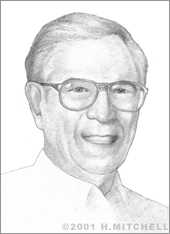Robert Fischell
Physicist Dr. Robert E. Fischell has earned nearly 200 U.S. and international patents over the course of his career, but he insists that his inventing proficiency happened by accident.
Fischell came from a modest background – his father never completed any education beyond the 8th grade. After Fischell’s graduation from college in 1951, he told his father he was going to attend the University of Maryland to do graduate work in physics. When his father asked him what physics was, he told him it was a science concerned with natural phenomena such as electricity, magnetism, light, heat, and atoms and molecules.
Later, as a professor at Johns Hopkins University, Dr. Fischell happened to be reading an academic journal when he saw an advertisement for a pacemaker battery that could last for up to two years before it needed to be replaced. Two years of power was not enough to impress him. He did some research and finally declared to a cardiologist friend of his at Johns Hopkins that he could design a pacemaker that would never wear out – one that would be rechargable through an interior nickel cadmium cell that could last indefinitely.
The rest, as they say, is history. Dr. Fischell went on to become a career inventor of medical device technologies. Eventually, he left Johns Hopkins to pursue his inventing interests privately, starting up several companies in the process, including Angel Medical Systems, Inc., Pacesetter Systems, Inc. (now St. Jude Medical, the second largest manufacturer of heart pacemakers), IsoStent, Inc. (now licensed to Johnson & Johnson), and NeuroPace, Inc.
Dr. Fischell’s work has resulted in the invention of a large variety of medical device improvements and technologies, from new and improved patterns for stents (tiny tubes placed over balloon catheters and inserted into obstructed arteries to allow blood flow), the first implantable insulin pump, and, of course, the first rechargeable pacemaker.
Frischell has served as president and chairman of the board of directors for AngelMed in Shrewsbury, New Jersey. Some of his many awards and honors include the 1984 Inventor of the Year Award and membership in the Space Technology Hall of Fame. He was awarded the TED (Technology, Entertainment, Design) prize in 2005. He has also held appointments at the Yale University School of Medicine and Johns Hopkins University School of Medicine.


